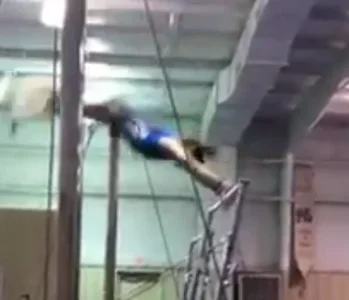Just a little re-cap. many of us have the general idea that shortening a gymnast's radius makes them go around faster. That's absolutely correct, but not enough. The shortened radius has to be timed correctly, held tightly for an adequate time, and lengthened gradually.
It sounds, from your description, that your gymnast is not shortening on the way up, but is waiting until well past half way up to shorten her radius. That kinda makes sense because a there's a lot of kids doing 3/4 giants/baby giants, that do nothing more than close their shoulders from the bottom of the swing, and extend their hips to the high bar so they have a shock absorbing bow shape to keep them from crashing as they gracefully flop into the high bar and then lift their shoulders to a support, and continue from there.
I picked out a few shapes that I think are key positions that need to be timed with little margin for error to maximize the energy from the down swing and quickly convert it to an inverted position to swing upward in. So first of all the swing itself does not invert the child's body, neither does shortening the radius. They could make that happen but you just can't get enough energy to simply shorten and make it around the bar.
This first frame shows the kid coming into the bottom of the swing, extended through her entire body as much as possible. She's pressed her chest and shoulders slightly forward to load them into a position from which they can counter the leg swing through the bottom....
The second frame shows that her feet have swung forward and the chest and hip press she had as she approached the bottom are gone. The action that straightened her is primarily the result of her feet being pulled downward and forward by the force of gravity and the additional forces created by reversing the downward trend to an upward trend. There can be a slight muscular effort to aid the transition from the legs behind to the legs in front position, but in my opinion that's a swing characteristic gradually grows on the gymnast as they become very familiar with the positions, forces, and timing.
Another important event took place just before this moment when she passed below the bar and became loaded with energy from gravity and swing. The idea is to take that energy and focus it with a quick motion to turn upside down and convert the circular swing to an elliptical, accelerated swing. This is where future swing problem are eliminated, or made worse, so this moment is the best moment to go to to solve problems.
In the third frame the gymnast has an easily notice closing in her hips, and a slight beginning of closing in her shoulders. I'd like to see a little more closing in her shoulders at this point because it makes giants, and giant related skills easier to do.
Another thought is that as this kid shortens while working toward becoming inverted. In a sense her quickly shortening body produced a quick pull against the bar, kinda like the pull that would be created by quickly swinging your legs front and back while hanging from a bar, or better still, hanging from still rings. That tug has an effect similar to pulling the string on a bow, and releasing it happens when the body first makes it's efforts to move from the shoulder and hip press to the closed hip and shoulder inversion.

The fourth frame shows an increase in hip closure and an obvious effort to close her shoulders. It may seem that the swing has moved her into these positions, but the reverse is true as the centrifugal force of the swing will tend to straighten her body. So these hip and shoulder angles are the result of deliberate and intense muscular effort. In other word, she has to make it happen, and do it with enough effort that she's very aware that those muscles are working. The harder they work, the better, as the turn to inverted (turnover) happens more quickly and builds it's own movement momentum that will help turn the giant over the top.... so no stall out.
The increased turnover speed brings with it a huge increase in upswing energy and the entire body mass begins to elevate as the turnover rotates closer to inverted.
The skill then gets to this point. If enough effort with the correct timing has been put into the turnover, the skill gets to relative state of negative gravity. In the sixth frame the gymnast is just entering the negative gravity stage, and only has to put a slight pressure on the bar to guide the energy to and past the handstand. She won't really need to roll her hands because the energy of this type of giant will pull her hands up and over.
So take a look at what she's trying to do, and then fill in the gaps with this drill, or something like it.
Have fun.
